| |
1W 87-110MHz FM Transmitter with 2N3886 Amplifier |
|
Powerful microtransmitter that can cover 3km range. To amplify the signal, a 2N3866A transistor is used that can provide up to 1W with gain > 10dB (24Volt). In our case the output power is about 100mW depending on the input power of 10mW and 9V battery power supply. The transistor Q1 must be mounted with a heatsink, the heatsink must have small dimensions (cylindrical) in order not to increase the parasitic capacitance. The trimmer R2 serves to adjust the bias of the transistor, start with the trimmer fully open and close by measuring the current absorbed by the 9V, in my case you get 100mW at the output with a current of 50mA not increase this value as you only increase the absorption by heating the transistor without increasing output power, because the input power is too low. Clearly the 9V battery will be able to provide 50mA only for a few hours, if necessary have greater autonomy should be used a larger battery, but it is no longer a bug but simply an FM transmitter.
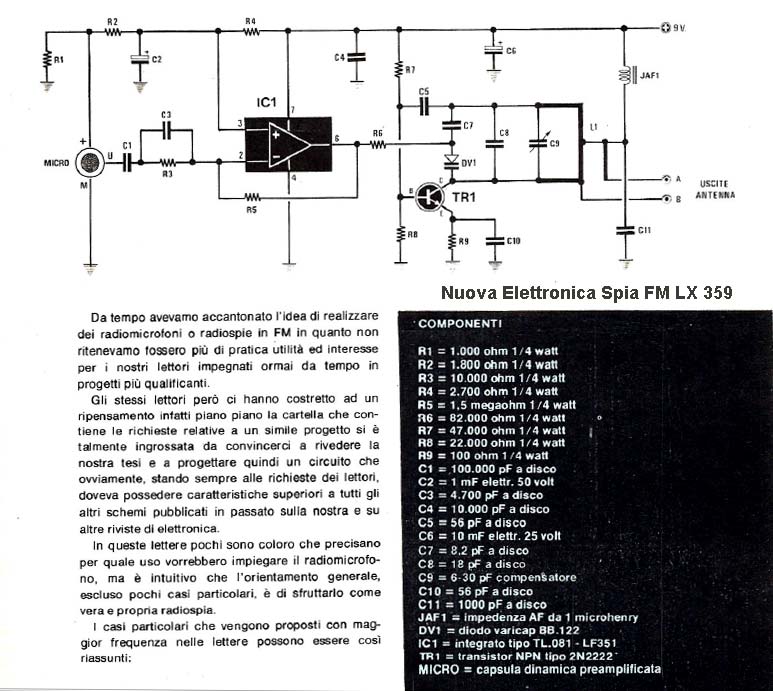
To obtain the best coupling it is necessary to adjust the impedances, adjust first C1 and C2 to obtain the maximum output signal on 50 Ohm load, then also C3 and C4 are set to obtain the best output coupling.
The output power should be read with a 50 Ohm input power meter, even only an anti-inductive resistance followed by a capacitor diode circuit and the tester may be sufficient to evaluate the power increments. Even with a 250Mhz oscilloscope it is possible to read the output signal, clearly the ideal instrument is the Spectrum Analyzer with at least 1000Mhz of band.
The filter composed of L2, L3 and C6 has the task of reducing the harmonics output, as low pass will let only the fundamental pass up to 110Mhz the higher frequencies are attenuated a lot.
To increase by about another 10dB the output power, equal to almost 1W, you can pair another equal stage, in cascade of this maybe powering it to 12V, in this case there is a greater heat sink and increase the regulation of the bias. The low pass filter eliminates harmonics and must only be output before the antenna.
This is the measurement of the output power of the LX359, we have seen that taking the signal directly from the collector of 2N2222 you get a higher output power, you see the two compensators for impedance matching, the value obtained with new 9V battery is equal to 11.22dBm which corresponds to 13.2mW. The output from point B even with the best adaptation provides us no better than 7.8dBm. I remember that the measure of power includes the fundamental as well as the energy of all subsequent harmonics. A good low-pass filter will eliminate a large part of the harmonics, allowing a more correct measurement of the fundamental.
This is the signal of the LX359 applied to the spectrum analyzer, the greater output power is obtained from the lower part of the output frequencies, ie at 80-87Mhz we get + 3dB compared to a 108Mhz calibration. You can see the subsequent harmonics that should be attenuated with the use of the low pass filter at the output.
The output of the LX359 with the SMA connectors, the output is taken directly from the case of the metallic 2N2222A.
Note the 2N3866 transistor mounted with the brass heatsink, you need to keep it a few mm away from the metal bottom to reduce capacity to ground. The low pass filter is made with 2 identical coils wound with 4 turns of 1mm wire on 6mm diameter.
The power output after optimizing the couplings, reaches 100mW, the Bias trimmer must be adjusted to have the minimum current and maximum output power by adjusting multiple couplings and Bias. In my case the current absorbed with 9V is between 35 and 50mA I advise not to increase the current as it could create instability in the transistor.
The tests with a 1/4 wave antenna gave excellent results and good quality of the voice heard well in a room even 4 meters away from the microphone.
By integrating the final stage close to the LX359 the reduced dimensions can be maintained by using small components, moreover, once the couplings have been optimized, the compensating trimmer can be replaced by fixed SMD capacitors. For a good realization, the bug, the linear stage and the low pass filter, should be inserted in a metal box and separated from each other with a screen between each stage.
With 9V battery the autonomy is reduced to 4-6 hours, if you want to have more autonomy, you need to use a good 9V power supply from the mains, or switch to a 12V battery but must be revised and adapted for a voltage highest.
Final version, mounted inside the plastic box, collector coupling with fixed divider 22 + 22pF, adjustment of coupling only for output, low pass filter with 0.3mm wire spools on 3mm diam.
In this configuration to the best coupling with 87Mhz we get 280mW output, they are too many, so we go down Bias (blue trimmer) to have only 100mW and 42mA absorption.
With a little 'patience you can fix everything without PCB, so there are no missing capabilities and the operation is very good and stable. With a GP antenna on the balcony you can comfortably reach 3KM, clearly on a frequency not to disturb commercial radios, type 86.0Mhz.
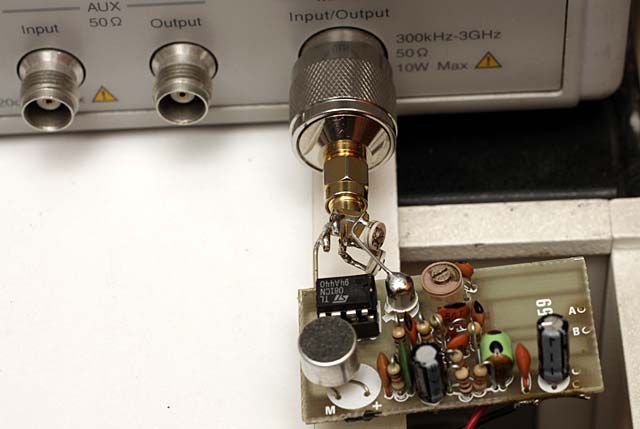
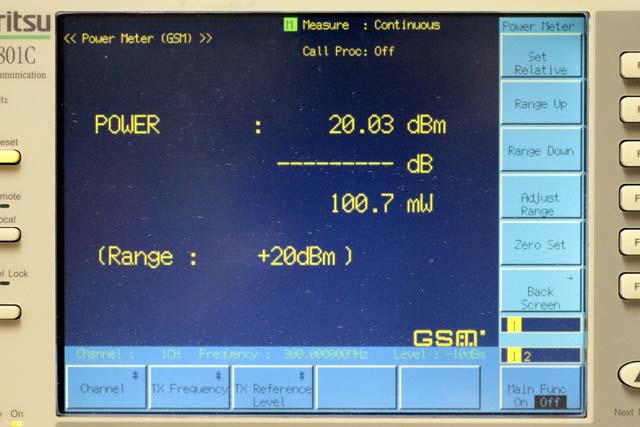
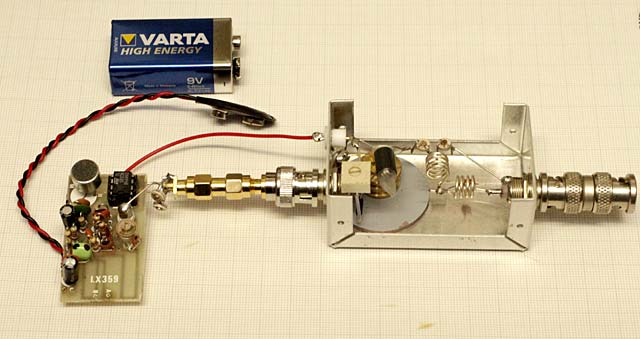

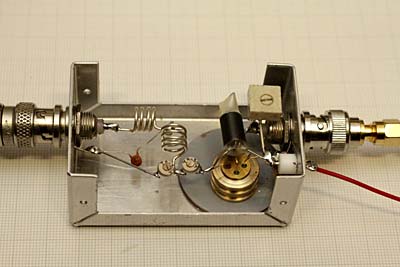
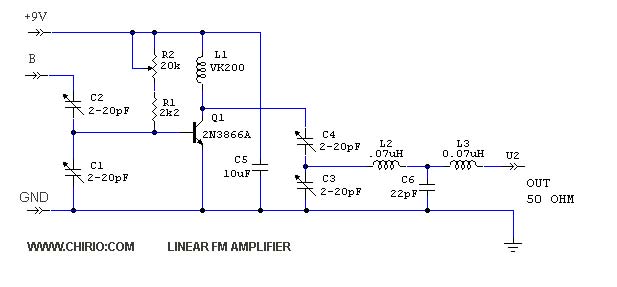
Related Links
Downloads
1W 87-110MHz FM Transmitter with 2N3886 Amplifier - Link
|
|
|
| |
Accurate LC Meter
Build your own Accurate LC Meter (Capacitance Inductance Meter) and start making your own coils and inductors. This LC Meter allows to measure incredibly small inductances making it perfect tool for making all types of RF coils and inductors. LC Meter can measure inductances starting from 10nH - 1000nH, 1uH - 1000uH, 1mH - 100mH and capacitances from 0.1pF up to 900nF. The circuit includes an auto ranging as well as reset switch and produces very accurate and stable readings. |
|
PIC Volt Ampere Meter
Volt Ampere Meter measures voltage of 0-70V or 0-500V with 100mV resolution and current consumption 0-10A or more with 10mA resolution. The meter is a perfect addition to any power supply, battery chargers and other electronic projects where voltage and current must be monitored. The meter uses PIC16F876A microcontroller with 16x2 backlighted LCD. |
|
|
|
60MHz Frequency Meter / Counter
Frequency Meter / Counter measures frequency from 10Hz to 60MHz with 10Hz resolution. It is a very useful bench test equipment for testing and finding out the frequency of various devices with unknown frequency such as oscillators, radio receivers, transmitters, function generators, crystals, etc. |
|
1Hz - 2MHz XR2206 Function Generator
1Hz - 2MHz XR2206 Function Generator produces high quality sine, square and triangle waveforms of high-stability and accuracy. The output waveforms can be both amplitude and frequency modulated. Output of 1Hz - 2MHz XR2206 Function Generator can be connected directly to 60MHz Counter for setting precise frequency output. |
|
|
|
BA1404 HI-FI Stereo FM Transmitter
Be "On Air" with your own radio station! BA1404 HI-FI Stereo FM Transmitter broadcasts high quality stereo signal in 88MHz - 108MHz FM band. It can be connected to any type of stereo audio source such as iPod, Computer, Laptop, CD Player, Walkman, Television, Satellite Receiver, Tape Deck or other stereo system to transmit stereo sound with excellent clarity throughout your home, office, yard or camp ground. |
|
USB IO Board
USB IO Board is a tiny spectacular little development board / parallel port replacement featuring PIC18F2455/PIC18F2550 microcontroller. USB IO Board is compatible with Windows / Mac OSX / Linux computers. When attached to Windows IO board will show up as RS232 COM port. You can control 16 individual microcontroller I/O pins by sending simple serial commands. USB IO Board is self-powered by USB port and can provide up to 500mA for electronic projects. USB IO Board is breadboard compatible. |
|
|
|
|
ESR Meter / Capacitance / Inductance / Transistor Tester Kit
ESR Meter kit is an amazing multimeter that measures ESR values, capacitance (100pF - 20,000uF), inductance, resistance (0.1 Ohm - 20 MOhm), tests many different types of transistors such as NPN, PNP, FETs, MOSFETs, Thyristors, SCRs, Triacs and many types of diodes. It also analyzes transistor's characteristics such as voltage and gain. It is an irreplaceable tool for troubleshooting and repairing electronic equipment by determining performance and health of electrolytic capacitors. Unlike other ESR Meters that only measure ESR value this one measures capacitor's ESR value as well as its capacitance all at the same time. |
|
Audiophile Headphone Amplifier Kit
Audiophile headphone amplifier kit includes high quality audio grade components such as Burr Brown OPA2134 opamp, ALPS volume control potentiometer, Ti TLE2426 rail splitter, Ultra-Low ESR 220uF/25V Panasonic FM filtering capacitors, High quality WIMA input and decoupling capacitors and Vishay Dale resistors. 8-DIP machined IC socket allows to swap OPA2134 with many other dual opamp chips such as OPA2132, OPA2227, OPA2228, dual OPA132, OPA627, etc. Headphone amplifier is small enough to fit in Altoids tin box, and thanks to low power consumption may be supplied from a single 9V battery. |
|
|
|
|
|
Arduino Prototype Kit
Arduino Prototype is a spectacular development board fully compatible with Arduino Pro. It's breadboard compatible so it can be plugged into a breadboard for quick prototyping, and it has VCC & GND power pins available on both sides of PCB. It's small, power efficient, yet customizable through onboard 2 x 7 perfboard that can be used for connecting various sensors and connectors. Arduino Prototype uses all standard through-hole components for easy construction, two of which are hidden underneath IC socket. Board features 28-PIN DIP IC socket, user replaceable ATmega328 microcontroller flashed with Arduino bootloader, 16MHz crystal resonator and a reset switch. It has 14 digital input/output pins (0-13) of which 6 can be used as PWM outputs and 6 analog inputs (A0-A5). Arduino sketches are uploaded through any USB-Serial adapter connected to 6-PIN ICSP female header. Board is supplied by 2-5V voltage and may be powered by a battery such as Lithium Ion cell, two AA cells, external power supply or USB power adapter. |
|
200m 4-Channel 433MHz Wireless RF Remote Control
Having the ability to control various appliances inside or outside of your house wirelessly is a huge convenience, and can make your life much easier and fun. RF remote control provides long range of up to 200m / 650ft and can find many uses for controlling different devices, and it works even through the walls. You can control lights, fans, AC system, computer, printer, amplifier, robots, garage door, security systems, motor-driven curtains, motorized window blinds, door locks, sprinklers, motorized projection screens and anything else you can think of. |
|
|
|